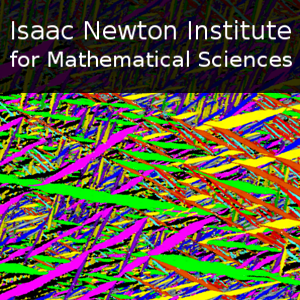Design of Liquid Crystals for Microscale Dynamics - 1
Duration: 59 mins 30 secs
Share this media item:
Embed this media item:
Embed this media item:
About this item

| Description: |
Lavrentovich, O
Tuesday 26th March 2019 - 10:15 to 11:15 |
|---|
| Created: | 2019-03-27 14:49 |
|---|---|
| Collection: | The mathematical design of new materials |
| Publisher: | Isaac Newton Institute |
| Copyright: | Lavrentovich, O |
| Language: | eng (English) |
| Distribution: |
World
|
| Explicit content: | No |
| Aspect Ratio: | 16:9 |
| Screencast: | No |
| Bumper: | UCS Default |
| Trailer: | UCS Default |
| Abstract: | Dynamics of small particles in fluids has fascinated scientists for centuries, since van Leeuwenhoek observed in 1674 tiny creatures, nowadays known as “bacteria”, swimming chaotically in a droplet of water. Much later, Brown found that even inanimate small particles, when placed in water, engage in a similar chaotic dynamics. If one could learn how to control and streamline the chaotic motion of particles such as bacteria and colloids at the microscale, that would open technological opportunities in areas such as transformation of stored or environmental energy into systematic motion, micro-robotics, transport of matter at microscale, etc. Remarkably, bacteria and colloids driven by an external field do not obey the laws of thermodynamics and can be used to extract a useful work. This set of lecture presents an approach to command microscale dynamics by replacing an isotropic medium such as water with an anisotropic fluid, a liquid crystal. The liquid crystals are formed by elongated molecules that tend to align parallel to each other along a common direction called the director. As a result, physical properties, such as electric conductivity or viscosity depend on the direction of measurement, whether it is parallel or perpendicular to the director. Orientational order of the medium leads to new dynamic effects, such as anomalous diffusion [1] and formation of particle-like solitary waves [2]. By using a newly developed technique of nano-photonic photoalignment, the liquid crystal director can be patterned into any predesigned structure [3]. We demonstrate that the patterned liquid crystals can control microscale dynamics of inanimate particles such as solid colloids, fluid droplets, through the effects of nonlinear electrophoresis [4] and electro-osmosis [5]. Moreover, plasmonic patterning of liquid crystals allows one to command the dynamics of swimming bacteria, guiding their trajectories, polarity of swimming and concentration in space [6]. The patterned director design can also be extended to liquid crystal elastomers, in which case the director field controls the thickness of elastomer coatings [7]. Some of these systems form an experimental playground for the exploration of out-of-equilibrium active matter, in which the levels of activity and degree of orientational order can be controlled separately.The work is supported by NSF DMREF DMS-1729509 and by Office of Science, U.S. Department of Energy, grant DE-SC0019105.[1] T. Turiv, I. Lazo, A. Brodin, B. I. Lev, V. Reiffenrath, V. G. Nazarenko, and O. D. Lavrentovich, Effect of Collective Molecular Reorientations on Brownian Motion of Colloids in Nematic Liquid Crystal, Science 342, 1351-1354 (2013).[2] B. X. Li, V. Borshch, R. L. Xiao, S. Paladugu, T. Turiv, S. V. Shiyanovskii, and O. D. Lavrentovich, Electrically-driven three-dimensional solitary waves as director bullets in nematic liquid crystals, Nature Communications 9, 2912 (2018).[3] Y. Guo, M. Jiang, C. Peng, K. Sun, O. D. Lavrentovich, and Q.-H. Wei, High-Resolution and High-Throughput Plasmonic Photopatterning of Complex Molecular Orientations in Liquid Crystals Advanced Materials 28, 2353-2358 (2016).[4] O. D. Lavrentovich, I. Lazo, and O. P. Pishnyak, Nonlinear electrophoresis of dielectric and metal spheres in a nematic liquid crystal, Nature 467, 947-950 (2010).[5] I. Lazo, C. H. Peng, J. Xiang, S. V. Shiyanovskii, and O. D. Lavrentovich, Liquid crystal-enabled electro-osmosis through spatial charge separation in distorted regions as a novel mechanism of electrokinetics, Nature Communications 5, 5033 (2014).[6] C. Peng, T. Turiv, Y. Guo, Q.-H. Wei, and O. D. Lavrentovich, Command of active matter by topological defects and patterns, Science 354, 882-885 (2016).[7] G. Babakhanova, T. Turiv, Y. B. Guo, M. Hendrikx, Q. H. Wei, A. Schenning, D. J. Broer, and O. D. Lavrentovich, Liquid crystal elastomer coatings with programmed response of surface profile, Nature Communications 9, 456, 456 (2018).
|
|---|---|
Available Formats
| Format | Quality | Bitrate | Size | |||
|---|---|---|---|---|---|---|
| MPEG-4 Video | 640x360 | 1.94 Mbits/sec | 866.14 MB | View | Download | |
| WebM | 640x360 | 516.34 kbits/sec | 225.08 MB | View | Download | |
| iPod Video | 480x270 | 522.16 kbits/sec | 227.55 MB | View | Download | |
| MP3 | 44100 Hz | 249.73 kbits/sec | 108.96 MB | Listen | Download | |
| Auto * | (Allows browser to choose a format it supports) | |||||

